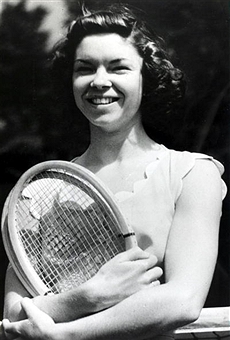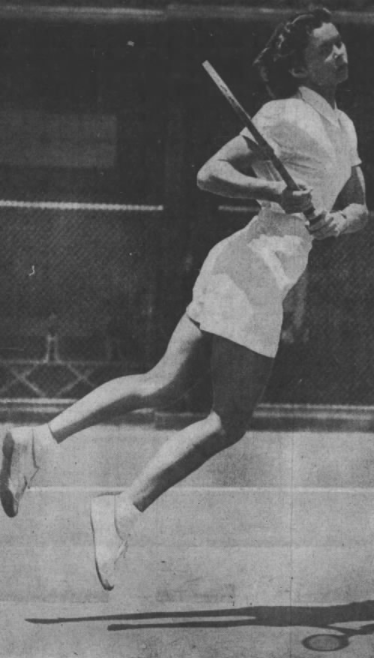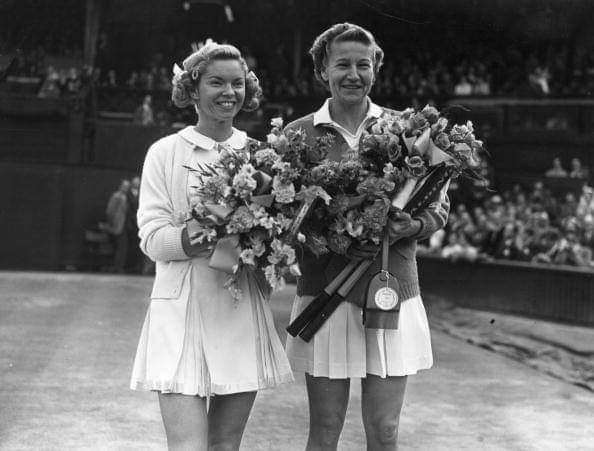In 2022, I’m counting down the 128 best players of the last century. With luck, we’ll get to #1 in December. Enjoy!
* * *
Beverly Baker Fleitz [USA]Born: 13 March 1930
Died: 29 April 2014
Career: 1946-1959 (14 seasons)
Plays: Ambidextrous (two forehands; served right-handed)
Peak rank: 3 (1954, 1955, 1958)
Peak Elo rating: 2,204 (2nd place, 1955)
Major singles titles: 0 (1955 Wimbledon finalist)
Total singles titles: 60
* * *
If you know one thing about Beverly Baker Fleitz, it’s probably that she was ambidextrous, hitting forehands off both wings. If you didn’t know that, boy am I excited to be the one to tell you. One of the best players never to win a major, this Californian won the 1948 national girls’ championship, beat Mo Connolly eight times, and reached the 1955 Wimbledon final as a mother, all without a backhand.
* * *
Baker Fleitz was, to some extent, naturally ambidextrous. The young Beverly Baker (Fleitz was her married name) threw righty and wrote lefty, so when she first picked up a racket, it came easily for the tiny 10-year-old to use her left hand on what would typically be her backhand side. A couple generations later, she would’ve been a natural proponent of the increasingly popular two-handed backhand, but developing her game in the 1940s, a double-hander would’ve been just as weird as her pair of forehands.
It wasn’t completely unprecedented to play with two forehands. The Australian Davis Cup player John Bromwich was a natural lefty who served right-handed, and he would hit one- or two-handed strokes at various times from both wings. He was part of the Aussie squad that traveled to Los Angeles for the Pacific Southwest tournament in 1938 and 1939, and he won the tournament the latter year.
The example of Bromwich, well-known to tennis aficionados in Southern California, may have given her father and coach, Frank Baker, the assurance to let Beverly do things her own way. It worked: She hit both forehands hard and deep. The only drawback of her unorthodox technique showed up at the net, where it took too long to switch hands. But like most of her peers, she was content to stay back, and her game thrived.
The novelty itself made life more difficult for opponents. She won the 1947 Los Angeles Metropolitan tournament before her 17th birthday and made her first trip East that summer. At the prestigious Eastern Grass Court Championships in Orange, New Jersey, she reached the final four before falling to the reigning Wimbledon champion, Margaret Osborne (later Osborne duPont), and won two matches at the national championships at Forest Hills.
Osborne’s 6-2 6-3 victory was hardly a close shave, but the veteran recognized her opponent’s potential. She described Baker as one of the game’s “coming players” and said, “Her ambidextrous style can be so confusing that at times you don’t know which way the ball is coming from.” While Osborne would win their next three meetings, Baker turned the tables when they clashed in a 1951 Wimbledon quarter-final.
The 17-year-old solidified her status as a player to watch in the fall of 1947, grabbing the title at the Pacific Southwest, the same event where the similarly unorthodox Bromwich had triumphed eight years earlier. Reigning national champion and SoCal product Louise Brough skipped the event due to illness, so it was left to the rest of the strong West Coast contingent to stop the teen with two forehands. They failed. In the final, Beverly lost only five games to top-tenner Pat Canning Todd.
As Baker’s results improved, the media quickly recognized the teen as more than a novelty act. Her small stature, at 5-foot-4 and under 120 pounds, left onlookers shocked by her power. Columnist Braven Dyer was awestruck by Baker’s performance against Todd: “Wham! How she socked home her drives, first with the right and then with the left.” Two years later, a writer for American Lawn Tennis claimed that he couldn’t recall a female player hitting harder than Beverly did.
One late-career assessment would’ve fit the young player just as well: “Her service is weak, her volleying indifferent and her overhead a chore that she shirks at all costs. She doesn’t need them. … The formula [is] simple: rifle the ball down a sideline and if it dared to come back, slam it down the other.”
* * *
Baker arrived on the American scene at a tough time for would-be stars. Brough’s 1947 Forest Hills title was the first of her six majors, and Osborne won the second of her own half-dozen at Wimbledon that year. The seemingly endless supply of elite American women would win Wimbledon and the US Nationals every year from 1938 to 1958, tacking on nine French Championships and four Australian titles in the same span.
The woman who would finally displace Brough, Osborne, and Doris Hart was still a few years away from her peak, but Baker spent the summer of 1948 getting a sneak preview of the future, facing off repeatedly against 13-year-old Maureen Connolly.
Baker and Connolly were among the small group of Californians sent to tour the West that summer. They played state and regional events in Salt Lake City, Denver, Tacoma, Seattle, and Vancouver. Baker won all five tournaments, and as Connolly also outclassed the provincial competition, Beverly and Little Mo met in a semi-final and four finals. (After the first stop in Salt Lake City, no one else made the mistake of seeding them in the same half of the draw.) While Connolly would eventually surpass her elder, Beverly remained a thorn in her side for years.
Baker went East again in 1948, winning the national junior title and excelling in adult tournaments, losing only to Brough and the now-married Osborne duPont. She reached the final again at the hometown Pacific Southwest, this time losing to a healthy Brough.
Her season tally of at least 48 wins against 9 losses was good for a national ranking of #5. My Elo ratings concur, placing her behind Brough, Osborne duPont, Hart, and Todd. In 1948, the top five Americans were all better than anyone the rest of the world had to offer.
With another decade to run on Beverly’s career, she had already nearly reached her peak. The cast of characters would shift, but she would remain a few rungs from the top.
* * *
There’s no shame, of course, in slotting in behind the likes of Brough, Hart, and Connolly. That’s particularly true for a person like Beverly Baker, who refused to let amateur tennis dominate her life.
As she ascended the ranks in early 1948, she told a reporter, “Tennis means everything to me right now, except school. So long as I’ve started playing, I want to reach the top, or as close to it as I can get, before anything else.” That included romance–a resolution that lasted barely a year.
In late 1949, she eloped to Las Vegas with Scotty Beckett, a fellow Southern Cal student and former child star from films such as “Our Gang.” Less than six months later, Baker filed for divorce, citing mental cruelty and bodily injury. She testified at trial that Beckett was “insolent, arrogant, abusive, belligerent and jealous.”
Her tennis bounced back from the ordeal. In the second half of 1950, she went 27-4, losing only to Hart and Osborne duPont. Baker didn’t sour on marriage, either. She wed John Fleitz in 1951, and the couple would have two children within five years.
* * *
After a 1951 season that included a trip abroad, a Wimbledon semi-final, nearly 100 singles matches, and six titles, family life slowed down Beverly Baker Fleitz’s playing schedule. In the amateur era, most women hung up their rackets upon their first pregnancy, and many quit as soon as they walked down the aisle. Beverly couldn’t see why: she missed less than a year for the birth of her first child, and sat out only 14 months for the second.
Between layoffs, she played the best tennis of her career. From her comeback in June 1953 to Wimbledon in 1956, when she withdrew due to her second pregnancy, she racked up 112 wins against only 6 losses, conceding defeat only to Doris Hart (twice), Louise Brough, Shirley Fry, Dorothy Knode and Barbara Breit. While she stuck close to home, playing the majority of her tennis in Southern California, she nonetheless piled up victories over the best of her peers: Connolly, Hart, Brough, Osborne duPont, Althea Gibson, and Darlene Hard.
The highlight came at Wimbledon in 1955. She cruised to the final with the loss of only 21 games in 6 matches, including a 6-3 6-0 dismantling of Hart. Baker Fleitz finally upset her old nemesis, winning the last nine games in a row. In the championship match, she faced Brough, who Beverly had beaten four times since her comeback, including once on grass.
Thanks to her performance in the semis and the recent results between the two women, Baker Fleitz entered her first major final as the favorite. She very nearly lived up to the billing. Brough was forced to deploy every trick she knew, occasionally suffering through passages like Beverly’s 10 consecutive points won early in the second set.
Baker Fleitz pushed her long-time rival to the limit, finally losing serve at 5-5 in the first set, allowing Brough to take it, 7-5. Both of Beverly’s forehands were firing, while her opponent barely had the stamina to survive another long set. Finally, with Baker Fleitz serving at 6-6, Brough secured a break with the shot of the match, a lunging stop-volley winner. Six points later, the former champion lifted the trophy again, defeating the woman with two forehands, 7-5 8-6.
The runner-up didn’t dwell on the defeat. She blitzed the field at the Irish Championships the next week in Dublin, then rushed home to take her daughter Kimberley to the beach.
* * *
Baker Fleitz retired from top-level tennis at the end of 1959, though the mother of two had hardly lost a step. She departed the scene as the two-time defending champion at the Pacific Southwest, having beaten top seed Maria Bueno in her final match at that event, two months after defeating British stars Angela Mortimer and Christine Truman in Wightman Cup.
Even then, she wasn’t quite done unleashing her power on the Los Angeles tennis elite. At the Southern California Sectional Championships in 1966, she entered the mother-daughter doubles with Kimberley and the wife-husband event with John. She and Kimberley won a match before losing in the quarters. With her spouse, she did a bit better.
You might have heard of their opponents in the final: Billie Jean King and her husband Larry. It wasn’t easy, but the Fleitzes came out on top, 5-7 8-6 6-3. I can only suspect that the husbands faced the brunt of the abuse that day. Beverly’s two forehands had been too much for a generation of women on tour. Larry King didn’t stand a chance.


